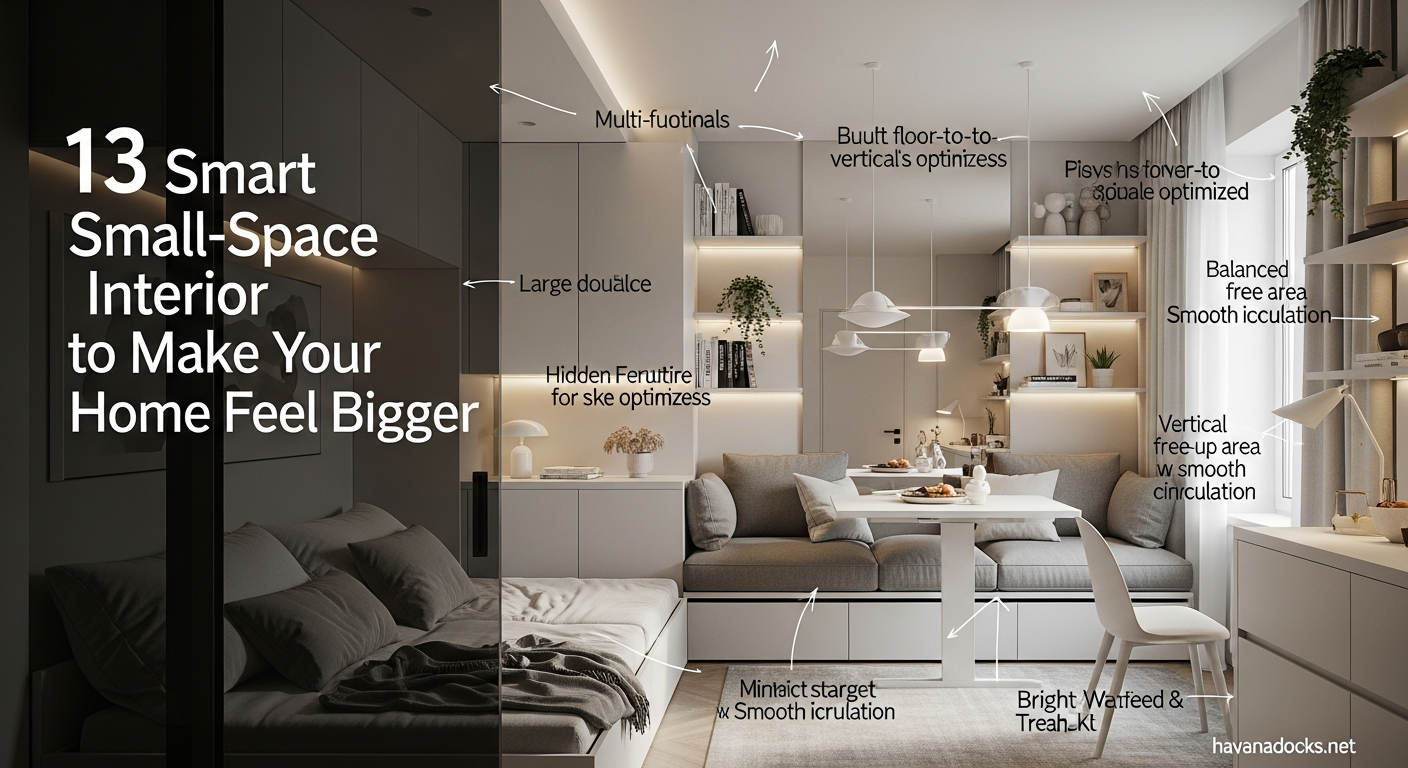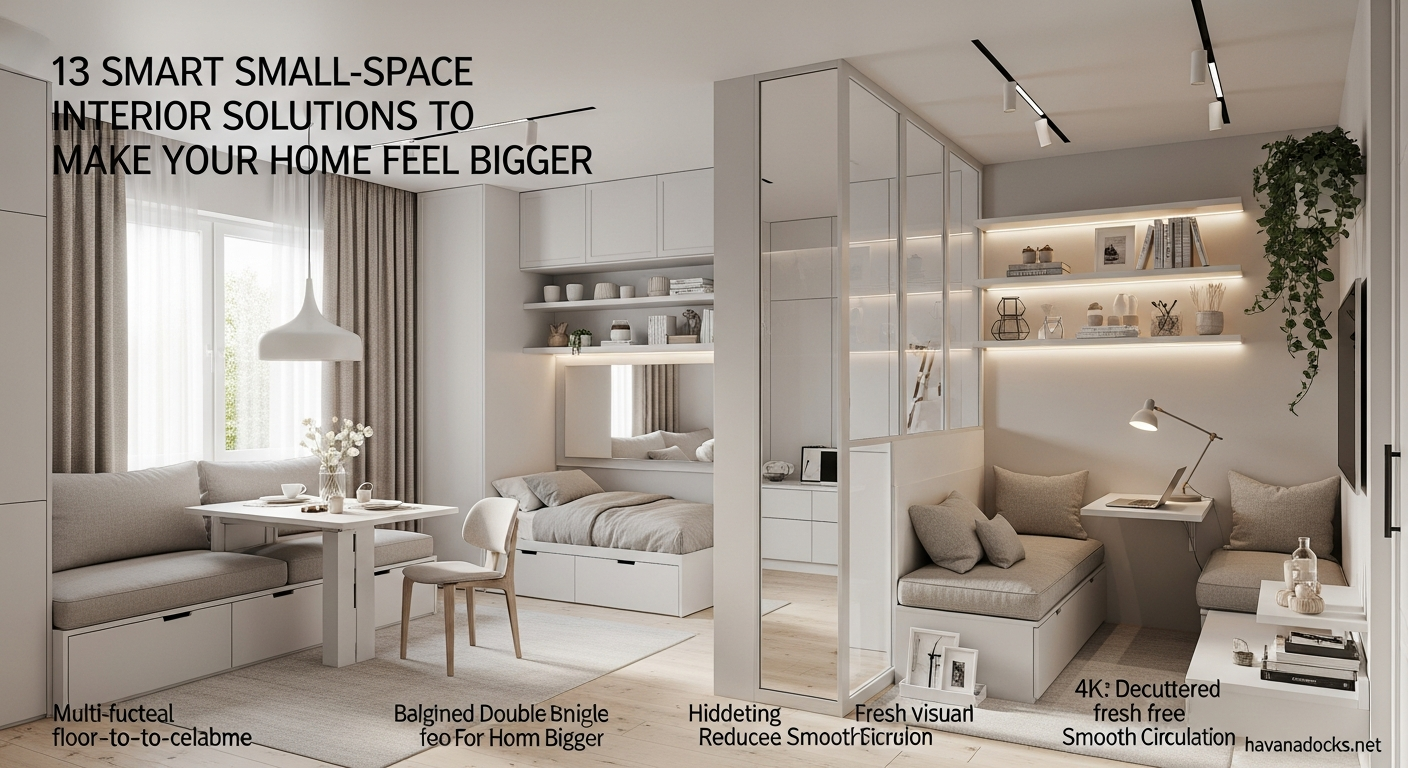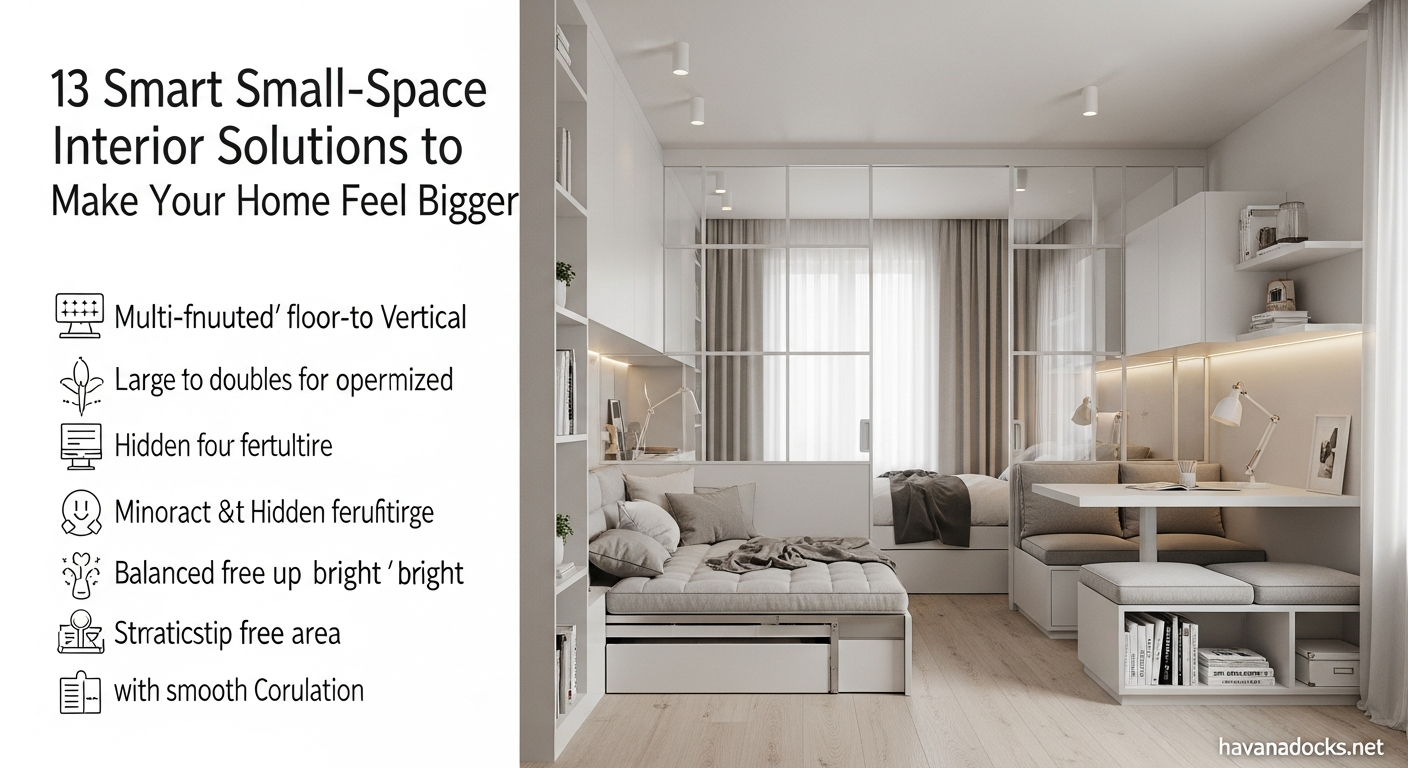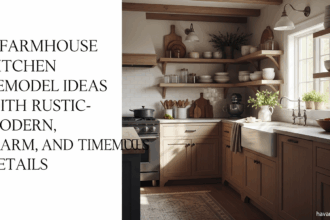1. Embrace Vertical Storage: Look Up!
13 Smart Small-Space Interior – One of the most effective smart small-space interior solutions is to utilize vertical space. Often overlooked, your walls offer a wealth of storage potential. Think beyond traditional bookshelves and explore creative ways to build upwards.
Shelving Units that Reach for the Sky
Floor-to-ceiling shelving units are game-changers. Not only do they provide ample storage for books, decor, and personal items, but they also draw the eye upwards, creating the illusion of higher ceilings. Opt for open shelving to maintain a sense of airiness and prevent the space from feeling too closed in. Consider adding decorative items strategically to break up the monotony and add visual interest.
Wall-Mounted Cabinets: Floating Elegance
Wall-mounted cabinets are another excellent way to maximize vertical space while keeping the floor clear. These are particularly useful in kitchens and bathrooms, where counter space is often limited. Choose cabinets with sleek, minimalist designs to avoid overwhelming the room. The space beneath these wall mounted cabinets can also be utilized for storage to further enhance space utilization.
Ladder Shelves: Leaning into Style
For a more casual and contemporary look, consider ladder shelves. These leaning shelves offer a stylish and functional storage solution that’s perfect for displaying plants, artwork, or books. They’re also relatively lightweight and easy to move, making them ideal for renters or those who like to rearrange their space frequently. They can be added to any living space or even the bathroom to give you an extra space to place your items.

2. Multi-Functional Furniture: The Transformer of Your Home
Smart small-space interior solutions often revolve around furniture that serves more than one purpose. Investing in multi-functional pieces is a surefire way to optimize space and reduce clutter.
Sofa Beds: Sleep Soundly, Save Space
Sofa beds are a classic example of multi-functional furniture. They offer comfortable seating during the day and transform into a bed for overnight guests. Look for sofa beds with storage compartments underneath to further maximize space. There are many different styles and sizes today and can greatly improve how you utilize your current sleeping arrangements.
Ottoman with Storage: Hidden Treasures
Ottomans with storage are a fantastic addition to any small living room. Use them as a footrest, extra seating, or even a coffee table, while simultaneously concealing blankets, pillows, or other living room essentials. Leather or upholstered variants offer a sophisticated look.
Coffee Tables with Lift-Top: Dine, Work, and Store
A coffee table with a lift-top mechanism provides a convenient surface for dining, working on a laptop, or playing board games. When not in use, the lift-top can be lowered, and the table returns to its original function. Many lift-top coffee tables also include storage compartments underneath. These lift-top mechanisms can provide much needed space and comfort.
3. Mirrors: Reflecting Light and Space
Mirrors are a designer’s best friend when it comes to creating the illusion of more space. Strategically placed mirrors can reflect light, making a room feel brighter and larger.
Full-Length Mirrors: Making a Statement
A full-length mirror is a must-have for any small space. Position it on a wall to reflect the entire room, instantly doubling the perceived square footage. Try positioning it near a window to reflect in the sunlight and increase how bright the room can be.
Mirrored Furniture: Subtle Illusions
Consider incorporating mirrored furniture, such as a mirrored dresser or side table, to add a touch of glamour while enhancing the sense of spaciousness. Mirrored surfaces reflect light and create intriguing visual effects, making the room feel more dynamic and open.
Gallery Wall with Mirrors: An Artistic Touch
Create a gallery wall that incorporates mirrors of various shapes and sizes. This adds visual interest and reflects light from multiple angles, further enhancing the sense of space. You can arrange these pieces based on the aesthetic feel that you are trying to convey.
4. Light and Bright Colors: Let There Be Light
Dark colors can make a small space feel even smaller and more claustrophobic. Opt for light and bright colors to create an airy and open atmosphere.
White Walls: A Classic Choice
White walls are a classic choice for small spaces because they reflect light and create a clean, minimalist aesthetic. White provides a blank canvas that allows you to add pops of color through furniture, artwork, and accessories. You can make this even more appealing by matching it different colors of lights.
Pastel Hues: Soft and Serene
Pastel hues, such as light blue, mint green, or lavender, are another excellent option for small spaces. These colors are soft and serene, creating a calming and inviting atmosphere. They also reflect light well, helping to brighten the room.
Monochromatic Color Scheme: A Unified Look
A monochromatic color scheme, using different shades and tints of the same color, can create a cohesive and sophisticated look that also enhances the sense of space. This approach allows you to add depth and dimension to the room without overwhelming it with too many colors. Using a single color will provide a feeling of cohesiveness and make the room feel much less cluttered.
5. Declutter and Organize: Less is More
One of the most fundamental smart small-space interior solutions is to declutter and organize regularly. A cluttered space will always feel smaller than it actually is.
Regular Purges: Saying Goodbye
Make it a habit to regularly purge unwanted items from your home. Donate, sell, or discard anything you no longer need or use. This will create more space and reduce clutter. Consider doing this every month or every 3 months to ensure that the level of clutter is maintained regularly.
Designated Storage Areas: A Place for Everything
Create designated storage areas for specific items. Use baskets, bins, and containers to organize your belongings and keep them out of sight. Label everything clearly so you can easily find what you need.
Utilize Under-Bed Storage: Hidden Potential
Under-bed storage is a valuable asset in any small space. Use flat storage containers to store seasonal clothing, extra bedding, or other items you don’t need access to frequently. These containers ensure that your home has a place for these items without the clutter.
6. Streamlined Furniture: Simple Silhouettes
Bulky, oversized furniture can quickly overwhelm a small space. Choose streamlined furniture with simple silhouettes to create a more open and airy feel.
Minimalist Design: Less is Indeed More
Embrace minimalist design principles. Choose furniture with clean lines, simple shapes, and a lack of unnecessary ornamentation. This will help to create a sense of calm and order in your small space.
Transparent Furniture: See-Through Style
Consider incorporating transparent furniture, such as a glass coffee table or acrylic chairs. These pieces visually disappear into the space, making the room feel larger.
Raised Furniture: Legs for Days
Opt for furniture with legs. This allows you to see more of the floor, which creates the illusion of more space. Raised furniture also makes it easier to clean underneath, which is a bonus.

7. Foldable Furniture: Adaptable Living
Foldable furniture is another excellent smart small-space interior solution. These pieces can be easily folded away when not in use, freeing up valuable space.
Folding Chairs: Extra Seating on Demand
Folding chairs are perfect for small dining areas or living rooms. They can be easily stored away when you don’t need them, and brought out when guests arrive. These chairs are generally light and can be used in different rooms if needed.
Folding Tables: Versatile Surfaces
A folding table can serve as a dining table, desk, or crafting table. When not in use, it can be folded away and stored flat against a wall or in a closet.
Murphy Beds: The Ultimate Space Saver
Murphy beds, also known as wall beds, are a game-changer for small spaces. They fold up into a wall cabinet when not in use, freeing up a significant amount of floor space. They are essentially a room transformer and can make drastic changes in how space is used.
8. Rugs: Defining Zones
While it might seem counterintuitive, rugs can actually make a small space feel larger by defining different zones within the room.
Large Rugs: Expanding the Borders
Choose a large rug that covers most of the floor area. This creates a sense of continuity and makes the room feel more expansive.
Rugs with Light Colors: Bright and Airy
Opt for rugs with light colors and subtle patterns. This will help to brighten the room and avoid overwhelming the space.
Strategic Placement: Visual Cues
Strategically place rugs to define different zones within the room, such as a seating area in the living room or a dining area in the kitchen.
9. Multi-Purpose Rooms: Adapt Your Space
Consider adapting rooms to serve multiple purposes. This is a great way to maximize space and functionality.
Home Office Nook: Work From Anywhere
Create a small home office nook in a corner of your living room or bedroom. Use a small desk and a comfortable chair, and add some shelves for storage. You can easily set these up with wall dividers which also add decorations to the space.
Dining Area in the Living Room: Seamless Transition
Combine your dining area and living room seamlessly. Use a small dining table that can also serve as a workspace or a game table. Use the space in any way and don’t feel obliged to do it one way.
Bedroom Office: Sleep and Work
If space is limited, consider setting up your home office in your bedroom. Choose a desk that can also be used as a vanity or a nightstand. This adds more flexibility to the room.
10. Clever Cord Management: Taming the Tangled Web
Cords can quickly clutter a small space and make it feel even more cramped. Implement clever cord management solutions to keep your wires organized and out of sight, contributing significantly to the feeling of spaciousness. In 2025, as homes become increasingly reliant on multiple devices, smart appliances, and integrated lighting systems, the importance of keeping cords invisible has never been greater. Effective cord management is no longer just a functional need—it has become a key part of creating clean, minimalist, and visually relaxing interiors.
One of the most effective strategies is to incorporate built-in cord channels directly into walls, floors, or furniture. These channels allow wires to run discreetly through hidden pathways, maintaining a seamless look across the room. Many modern furniture pieces—especially desks, nightstands, TV consoles, and shelving units—now come with pre-designed slots, openings, or rear compartments specifically made to conceal cables. Opting for furniture with built-in cable systems can instantly elevate the aesthetic of a compact room.
Another increasingly popular solution is the use of corded accessories designed with aesthetics in mind. Fabric-covered cables, braided cords, and color-coordinated wire organizers are becoming mainstream, allowing homeowners to maintain both function and beauty even when cords must remain partially visible. These accessories blend into the decor instead of standing out, helping create a cohesive and intentional design.
For areas like entertainment centers or home offices, where devices tend to accumulate, vertical cord mounts and under-desk baskets are essential. These pieces ensure cables rise neatly toward power outlets or stay tucked beneath the tabletop. Combined with adhesive cable clips, Velcro ties, or magnetic wraps, these tools prevent cords from tangling or dangling messily. Even a simple adjustment—such as binding device chargers together rather than letting them spread across a surface—can significantly reduce visual clutter.
Small homes also benefit greatly from wireless technology, which continues to expand in 2025. Wireless lighting systems, Bluetooth speakers, smart home devices, and cordless appliances eliminate the need for multiple power cords altogether. Even desks and countertops are becoming more streamlined thanks to built-in wireless charging pads that reduce dependence on physical cables. Choosing wireless options whenever possible is one of the easiest ways to keep a compact home clean and spacious.
In multifunctional spaces, where the same area may be used for working, relaxing, and entertaining, using elegant power solutions such as pop-up outlets or floor-mounted sockets can help reduce cable sprawl. These outlets stay hidden when not in use and appear only when needed, offering both convenience and aesthetic appeal. They are especially useful in multipurpose living rooms, dining areas, and studio apartments.
For renters who cannot alter walls or furniture, there are still excellent temporary solutions. Decorative cord covers, adhesive raceways, or woven baskets placed strategically near outlets can hide routers, chargers, and extension cords while adding texture and warmth. Using furniture placement—such as positioning a console table behind a sofa—can also effectively disguise cords without any installation needed.
Ultimately, thoughtful cord management plays a crucial role in shaping the overall atmosphere of a home. With organized cables and hidden wiring, a small space feels larger, lighter, and more intentional. By integrating smart storage tools, wireless technologies, and visually harmonious accessories, homeowners can maintain a clean and spacious environment that supports both daily living and modern design sensibilities.
Cord Organizers: Untangled Bliss
Use cord organizers to bundle cables together and prevent them from tangling. These small, inexpensive devices can make a big difference in the overall tidiness of your space.
Cable Channels: Hidden in Plain Sight
Conceal cords along walls using cable channels. These adhesive-backed channels allow you to run cables discreetly and prevent them from becoming a tripping hazard.
Furniture with Cord Management: Built-In Solutions
Choose furniture with built-in cord management features, such as desks with cable grommets or media consoles with cord cutouts. These pieces help to keep your cords organized and out of sight.
Hidden Power Strips: Out of Sight, Out of Mind
Mount power strips inside cabinets or behind furniture to keep them hidden. This prevents unsightly power strips from cluttering your floor or countertops.
Wireless Solutions: Cutting the Cord
Embrace wireless technology whenever possible. Opt for wireless speakers, wireless keyboards, and wireless mice to reduce the number of cords in your space. Wireless devices are now affordable and readily accessible.
11. Embrace Minimalism: Keep it Simple
Embrace the simplicity of minimalism. Limit the number of possessions you have and focus on quality over quantity. Only keep items that you truly need and love. It will create a very stress-free environment that is relaxing.
Curate Your Belongings: Intentional Living
Carefully curate your belongings. Choose items that are functional, beautiful, and meaningful to you. Get rid of anything that doesn’t serve a purpose or bring you joy.
Visual Harmony: Cohesive Aesthetics
Create visual harmony by choosing furniture and accessories that complement each other. Stick to a limited color palette and avoid cluttering the space with too many patterns or textures.
Focus on Functionality: Practical Minimalism
Focus on functionality when choosing furniture and accessories. Choose pieces that are practical and serve a purpose, rather than simply taking up space.
12. Natural Light is Your Friend: Let the Sunshine In
Maximize natural light in your small space. Natural light makes a room feel brighter, more open, and more inviting.
Sheer Curtains: Filtering the Light
Use sheer curtains to filter natural light into the room. Sheer curtains allow light to pass through while still providing some privacy.
Keep Windows Clear: Unobstructed Views
Keep windows clean and free of obstructions. Remove any bulky curtains or blinds that block natural light. This gives you a view to the outside world without any hindrances.
Light Reflecting Window Treatments: More Light
Use light-reflecting window treatments to maximize natural light. Light-colored blinds or shades can reflect sunlight back into the room, making it feel brighter.
Add Indoor Plants: Connecting with Nature
Adding indoor plants is another smart small-space interior solution. Plants bring the outdoors in and create a sense of freshness and vitality. They also help to purify the air and improve your overall well-being. They can brighten up the room in a meaningful way and can also add some texture to the overall feel of the space.

13. Extend Shelving Beyond Walls: Create Storage Islands
Extend a shelving unit beyond the walls to create an organized space island. These shelves can hold things and divide rooms at the same time. For example, a set of waist-high shelves between the dining and living area can act as a sideboard, a serving table, and some storage as well. The beauty of the shelves in this scenario is that they visually don’t “close” either room from each other, which is perfect to open up spaces.
Conclusion
Small space living presents unique challenges, but with the right approach and implementation of smart small-space interior solutions, you can create a home that is both functional and beautiful. By embracing vertical storage, multi-functional furniture, mirrors, light colors, and decluttering strategies, you can maximize every square inch of your space and create a haven that feels spacious, organized, and inviting. So, embrace the challenge, get creative, and transform your small space into the home of your dreams! These tips and strategies will help you to organize your small spaces effectively.






